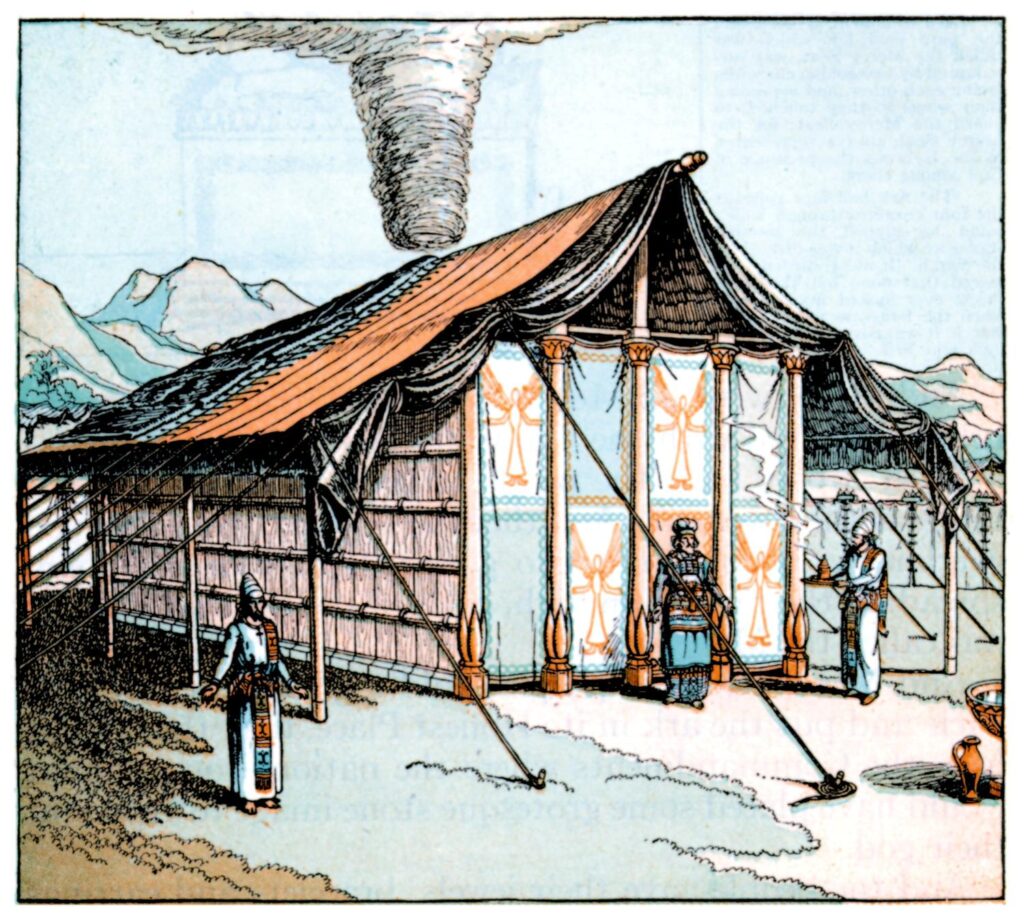
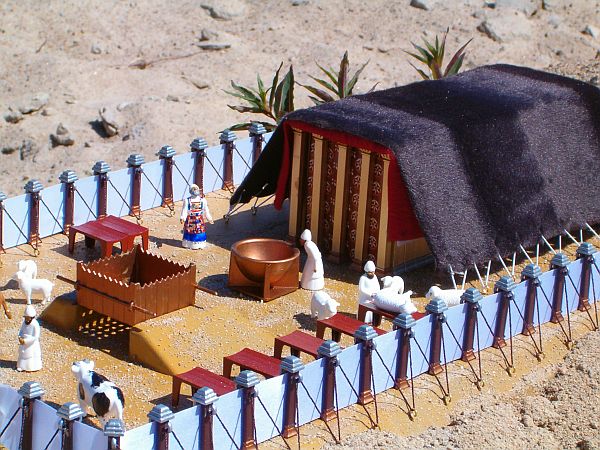
The Tabernacle of Moses was literally a three-dimensional gospel message tract. It is the visual demonstration of the whole message of the Bible in a building—the blueprint of the plan of redemption of wayward man. It was a functioning masterpiece of artwork demonstrating the Father’s love for his people, of his desire to commune and to communicate with Israel—his treasured possession, those he had hand picked and called out from the 70 nations of the world. Not only did the tabernacle involve the sense of sight, but the other four senses as well: sound, smell, touch, and taste. It also engaged and even challenged the heart, emotions, mind and spirit of man. The Tabernacle of Moses was a vehicle for the Creator of the universe to communicate with man using a panoply of communicative devices all of which pointed to the coming Messiah, the Redeemer of mankind who would die for the sins of the world to restore man into a loving relationship with his ever-loving, gracious, and longsuffering Father in heaven.
The Altar of the Red Heifer (Num 19:1–11)
The altar of the red heifer is where our journey through the Tabernacle of Moses begins; no! Rather this is where our journey toward the throne room of heaven begins, which is the very presence of the Almighty Creator of the universe. His name is Yehovah Elohim, and his arms are open wide to receive you, if you know the way to him.
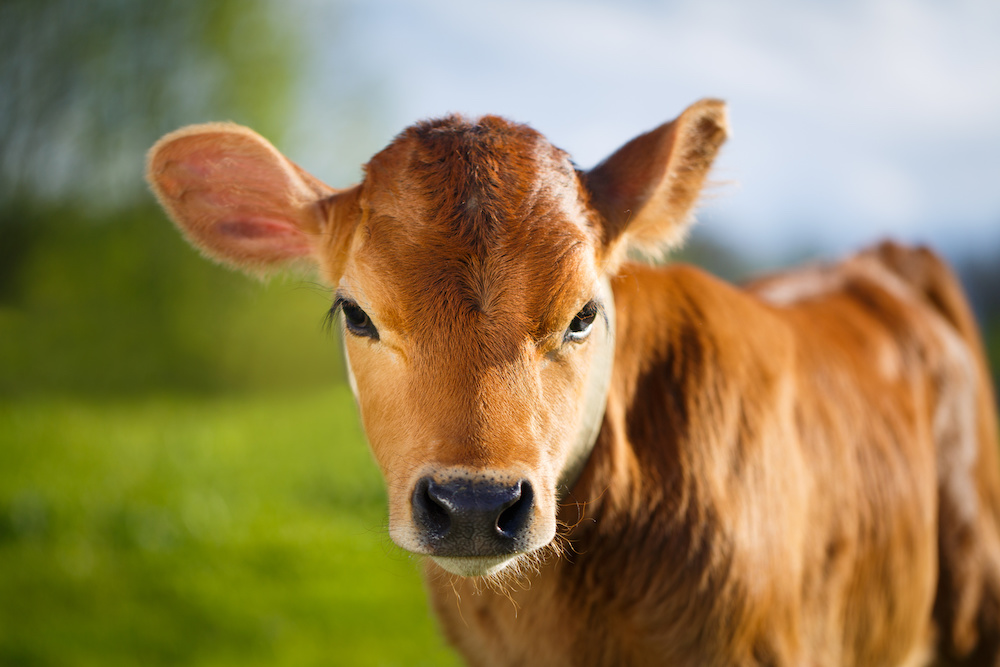
This altar is the very spot where the earthling and the finite reaches out a feeble and virtually helpless arm skyward toward the infinite—the supreme Creator of all. Where a small, weak child extends his scrawny arms up to his all-powerful and all-loving Father, who towers above him, his head reaching into the clouds, or so it seems. This is the first of many steps that a mortal being takes as he or she begins to hearkens to and attunes their mind and heart to the flickering spirit deep inside their innermost depths. This is where the human begins to awaken to his deepest yearnings to know where he came from, why he is alive, where he is going, the meaning of life, his purpose and destiny, and, most importantly, to satiate the thirst and the intense desire to live forever—yea! to somehow achieve immortality.
So what is this all-important geographical spot where the One who has all power, who gave the gift of life to each human, and who long ago established and prescribed the one and only path that one must follow if they want to find themselves and, ultimately, to find him? It is at this spot where heaven demands that each person lose it all to gain it all; to lose himself or herself to find themselves; to become poor that one might become rich; yes, and to die that one might live.
This place of transaction is a literal altar where something and, eventually, Someone died so that you and I might live forever in the glorious, ethereal and supernal Presence of YHVH Elohim, the Creator of us all. And the Tabernacle of Moses shows us the way.
Thirty-five hundred years ago when YHVH instructed the children of Israel to build a glorified tent called the Tabernacle of Moses where he might dwell among them, lead and guide them into a special relationship with him, he also instructed them to build an altar in a special place outside that tabernacle. This is the place that those who would enter the tabernacle would first be required to visit to be cleansed and purified in order to come into the tabernacle. They had to be cleansed of any filth that prevented them from coming into the presence of their holy or pure and perfectly righteous Creator. That is to say, each person had to deal with the sin in his life. This was the transaction that each one had to make before taking another step heavenward, so to speak. They had to acknowledge their sinfulness, repent of that sin, and then be cleansed or pardoned of that sin. There was no other way to gain a ticket, so to speak, to go inside.
The ritual on this altar involved the sacrifice of a perfectly spotless red heifer cow that symbolized innocence or sinlessness. Those who were chosen to minister before YHVH in the tabernacle had to then take the ashes from the heifer that was sacrificed as a burnt offering, mix it with water and then be ritually purified by this lye water. Lye is found in ashes and, interestingly, was, in former times, the major cleansing agent traditionally used in soap. YHVH prescribed and accepted this cleansing ritual as a suitable precursor to initiate his servants, the Levites, to minister before him in the Tabernacle.
But this red heifer ritual was not an end all. Like everything in the Tabernacle of Moses, and like a sign on a highway that gives the number of miles to your destination, this ritual prophetically pointed to something or, more accurately, to Someone who was yet to come who would ultimately cleanse humans from their sins once and for all. Can you now see where this is going?
That Person was Yeshua the Messiah, and the spot was where he was crucified for the sins of all those who would make the transaction with YHVH Elohim, like the Levites of old, to acknowledge their sin, repent of it, forsake it and be cleansed of their sin filth by Yeshua’s blood. He was crucified as our sin atonement outside of the temple in Jerusalem in the very same area where the red heifer of old was traditionally sacrificed on the Mount of Olives. The writer of the Epistle to the Hebrews explains this as follows:
We have an altar from which those who serve the tabernacle have no right to eat. For the bodies of those animals, whose blood is brought into the sanctuary by the high priest for sin, are burned outside the camp. Therefore Yeshua also, that He might sanctify the people with His own blood, suffered outside the gate. Therefore let us go forth to Him, outside the camp, bearing His reproach. (Heb 13:11–13)
Yes, each of us must visit the cross of Yeshua and be sprinkled by his blood or cleansed of our sin if we want to come into the presence of Elohim (Eph 1:7; Heb 10:19–22; 1 Pet 1:18–19; 1 John 1:7). To enter the ancient tabernacle without proper cleansing was a death sentence, even as the wages of sin is death (Rom 6:23), and no sin can come into the presence of the most holy YHVH Elohim. All sin had to remain outside the precinct where YHVH abode then even as now, which the Tabernacle of Moses symbolically represented. Similarly, and more importantly, no one can remain in their sinful state and expect to have any spiritual relationship with YHVH Elohim. It is impossible and not even remotely permitted. There is no other way to the our Father in heaven except through the cross and blood of Yeshua (John 14:6 ; Acts 4:12), which the altar of the red heifer prophetically symbolized.
The Outer Curtain (Exod 27:9–19)
When approaching the Tabernacle of Moses, the first thing one would see was a tall curtain-like fence around the whole structure (Exod 27:9–19). This was the tabernacle’s outer court, which was approximately 150 feet long by 75 feet wide in size or 11,250 square feet, which is about one-fourth of an acre.
The curtains of the outer court were made of fine white linen and was seven-and-a-half feet tall. The linen curtains symbolically represent the robes of righteousness that the bride of Yeshua will wear on her wedding day (Rev 19:8).
Sixty pillars supported the outer curtain. The pillars were set in heavy bronze (or brass) bases topped by silver capitals. These pillars represent redeemed humanity wearing robes of righteousness. Wood symbolizes humanity, while bronze is a biblical metaphor and symbol for divine judgment against man because of sin, while the silver represents redemption or Elohim’s ransom price for man’s sin.
The Curtain-Door to the Tabernacle (Exod 27:16–17)
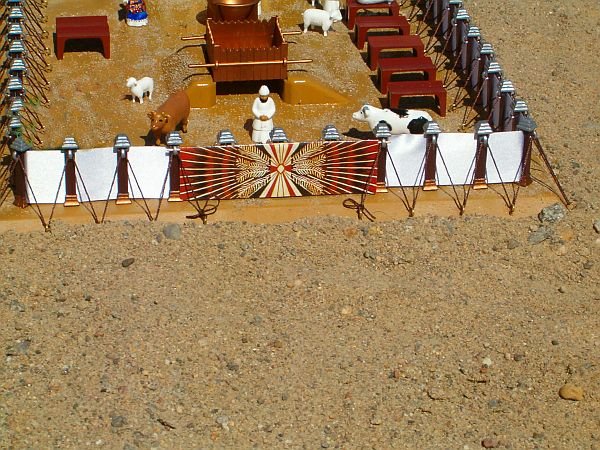
There was only one way into the Tabernacle of Moses, and it was through a curtain-door. This curtain-door of the outer court curtain-fence contained three colors woven into white linen fabric: blue, purple, crimson, and white. These four colors had deep prophetic significance.
These four colors prophetically and symbolically speak of the different attributes of Yeshua, whom Scripture likens to the door of our salvation (John 10:1–18). When combined, they form a full picture of Yeshua, the Redeemer and Savior of Israel as well as those people from the nations, who will be brought to him by the preaching of the gospel, and then will be grafted into the commonwealth or nation of Israel and its covenants with Elohim (Eph 2:11–19 cp. Rom 11:11–32). Only through Yeshua can man come to the Father, have salvation (John 14:6; Acts 4:12), eternal life and inhabit the glorious New Jerusalem as prophetically pictured by the glory cloud over the Holy of holies in the tabernacle. The four colors also correspond to the four faces of the living beings around the throne of Elohim (Ezek 1).
- The color crimson symbolizes the human aspects of Yeshua, for red is the color of man and red clay from which YHVH created man (Heb. adam meaning “ruddy, red”; cp. adama meaning “earth”). Some Bible commentators believe this points to the Gospel of Mark, which reveals the nature of Yeshua at the pashat (referring to “the simpleor plain level”) of biblical understanding. Some see this as corresponding to the ox cherubim and the tribe of Ephraim, which had on its banner an ox. According to Hebrew roots commentator and linguistic scholar James Trimm, the Gospel of Mark presents the Messiah as the servant (i.e., the servant who purifies the goyim or people of the nations in Isa 52:13, 15) and is the “my servant the Branch” of Zechariah 3:8, who is symbolized by the face of the ox in Ezekiel chapter (the ox being a servant, a beast of burden). Mark does not begin with an account of the birth of Messiah as do Matthew and Luke because, unlike the birth of a King, the birth of a servant is unimportant, all that is important is his work as a servant which began with his immersion by John. Thus Mark’s simplified account omits any account of Yeshua’s birth or preexistence and centers on his work as a servant who purifies the people of the nations.
- The color white symbolizes the righteousness of Yeshua. Some Bible commentators believe this points to the Gospel of Luke which reveals the nature of Yeshua at the remez (referring to “the hint”) level of biblical understanding. Some see this as corresponding to the man cherubim in Ezekiel chapter one and the tribe of Reuben, which had on its banner a man. Trimm states that Luke wrote a more detailed account for the high priest Theophilus (a Sadducee). The Sadducees were rationalists and sticklers for details. Luke presents Yeshua as the “Son of Man” and as “the man whose name is the Branch” (Zech 6:12), who is presented as a high priest and is symbolized by the face of the man in Ezekiel 1. Luke wants to remind by remez (or by implication) the high priest Theophilus about the redemption of the filthy high priest Joshua (Zech 6) and, therefore, its prophetic foreshadowing of a “man” who is a Messianic “Priest,” and who can purify even a high priest.
- The color purple symbolizes the regal or kingly aspects of Yeshua. Some Bible commentators believe this points to the Gospel of Matthew, which reveals the nature of Yeshua at the drash (or the allegorical or homiletical) level of biblical understanding. Some see this as corresponding to the lion cherubim and the tribe of Judah, which had on its banner a lion. Trimm writes that Matthew presents his account of Yeshua’s life as a midrash (or sermon) to the Pharisees, as a continuing story tied to various passages from the Tanakh (for example Matt 2:13–15 presents an allegorical understanding of Hos 11:1). As a drash level account of Yeshua’s kingly role, Matthew also includes a number of parables in his account. Matthew presents Messiah as the King Messiah, the Branch of David (Jer 23:5–6 and Is. 11:1f) as symbolized by the face of the lion in Ezekiel 1. Moreover, the lion corresponds to the tribe of Judah (Gen 49:9), and Scripture calls Yeshua “the Lion of the tribe of Judah” (Rev 5:5).
- The color blue symbolizes the heavenly or divine aspect of Yeshua the Messiah. Some Bible commentators believe this points to the Gospel of John as revealing the nature of Yeshua at the sod (or the mystical) level of biblical understanding more than the other Gospels. Some see this as supposedly corresponding to the eagle cherubim and the tribe of Dan, which supposedly had on its banner an eagle, although the scriptural proof for this seems to be lacking. According to Trimm, John is addressing the mystical Essene sect and concerns himself with mystical topics like light, life, truth, the way and the Word. John includes many sod-level interpretations in his account. For example John 1:1 presents a sod–level understanding of Genesis 1:1. John 3:14; 8:28 and 12:32 present a sod–level understanding of Numbers 21:9, and John 6:35–40, 50–58 of Exodus 16 with its account of the manna. (All of Trimm’s references were from his now defunct internet site http://www.jios.org/The%20Synoptic%20Solution_jt.html.)
The Altar of Sacrifice (Exod 27:1–8)
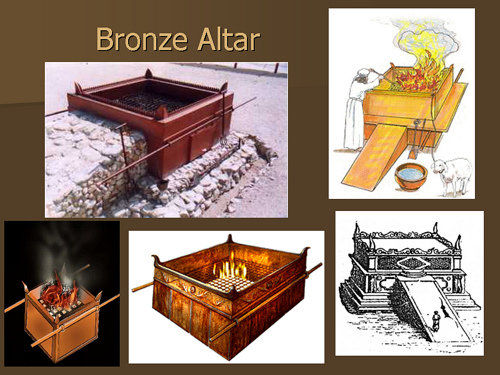
Just inside the door of the tabernacle was the altar of sacrifice. It was constructed of acacia wood overlaid with bronze. These materials are biblical prophetic symbols of Yeshua’s humanity (i.e., the wood) and his bearing the judgment for men’s sins on the cross (i.e., the bronze).
The blood of an animal that was sacrificed on the altar was poured out on the ground at the base of the altar. This prophetically pictured Yeshua shedding his blood at the cross for man’s redemption.
Two lambs were offered at the altar morning and evening (Exod 29:38–42). This pictures man’s need to come humbly before our Father in heaven morning and evening in prayerful devotion as living sacrifices to confess one’s sins as well as to praise, worship and thank him (Ps 51:16–17; Heb 13:15; 1 John 1:7–9).
The Bronze Laver (Exod 30:17–21)
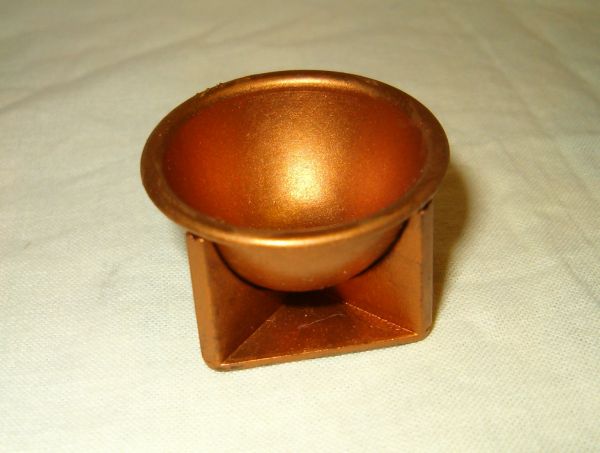
A large bronze basin that was located in the tabernacle courtyard between the altar of sacrifice and the door of the tabernacle was fabricated from mirrors donated by the Israelite women (Exod 38:8). Perhaps James apostle had this basin in mind when he speaks of the need for the saint to be a doer of the Word of Elohim, not just a hearer, for a hearer and not a doer is like one who beholds himself in the spiritual mirror of Elohim’s Word and then goes and forgets what he looks like, thus failing to allow the Word to transform him (Jas 1:22–25). We know that water is a biblical metaphor for YHVH’s Word (Eph 5:26; Tit 3:5; Heb 10:22; Deut 32:2) as well as YHVH’s Set-Apart Spirit (John 7:37–39).
In the laver, the priests were to wash their hands and feet before going into the tabernacle, so that they would not die. The hands and feet represent the entire body, since they are the highest and lowest parts of the body. They also represent our direction and our action and the fact that everywhere we go and all that we do must be pure from the defilement of sin before coming into the presence of YHVH.
Based on the components of the bronze laver’s construction and its function, we deduce that this tabernacle furnishing symbolically pictures the concept of water baptism for the remission of sins, which is the first act of obedience after a person repents of their sins and accepts Yeshua as their Redeemer or Savior and Master (Matt 28:19; Mark 16:16; Acts 2:37–38 cp. Rom 6:1–7).
From the Outer Court to the Inner Sanctuary
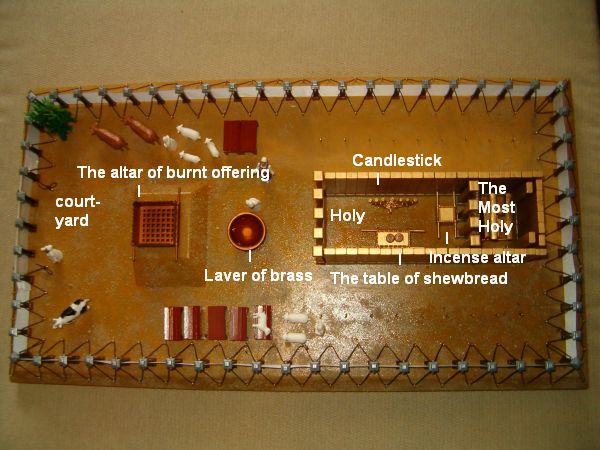
In the outer court, the theme was judgment against sin and cleansing and redemption therefrom, while in the inner sanctuary, called the holy place, the theme was spiritual growth and coming into a spiritual relationship with our Father in heaven through Yeshua.
Physical symbols therein involved light, food and fragrance, which are biblical metaphors for one’s relationship with Elohim as we will discuss below. Entering into the tabernacle’s sanctuary represents steps of maturity in the believer’s life and progression in one’s spiritual focus. Some believers never leave the outer court, for their spiritual lives never evidence the deeper spiritual attributes of walking in the Spirit and manifesting the fruit and gifts thereof as well as adopting a lifestyle of praise, worship and abiding in YHVH presence.
Paul likens one’s spiritual life to becoming a living sacrifice, holy and acceptable to Elohim and having our hearts and minds transformed spiritually and coming into the perfect will of Elohim (Rom 12:1–2).
The Boards of the Sanctuary (Exod 26:15–30)
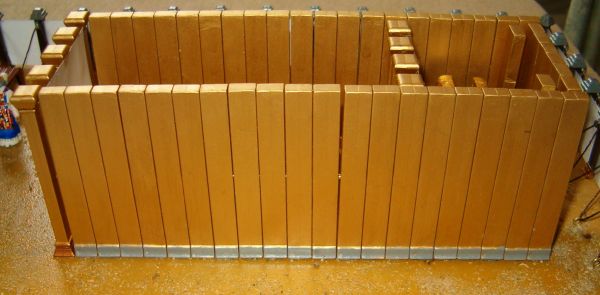
The walls of the tabernacle were constructed of vertical boards (20 on each side and 6 on the back) and were made of acacia wood covered in gold sitting in silver bases. The boards were held upright by five horizontal acacia wood bars also overlaid in gold that ran the length of the walls. The vertical boards standing tall symbolically picture YHVH’s upright or righteous saints.
Another biblical name for Israel is Yeshurun meaning “upright” (Deut 32:15; 33:5; 33:26; Isa 44:2). This was YHVH’s prescribed spiritual destiny for his people if they would obey him and abide by his standards of righteousness.
The Bible also refers to the saints as the temple of YHVH’s Spirit (1 Cor 3:16; 6:19; 2 Cor 6:16) and as pillars in YHVH’s eternal New Jerusalem temple (Rev 3:12). The courtyard’s outer curtain as well as the boards of the tabernacle itself prophetically represent YHVH’s saints.
Additionally, wood overlaid with gold in silver bases symbolizes the saint’s redemption (the silver) with the divine nature of Yeshua (the gold). It also speaks of the two-fold nature of Yeshua, who was both human (wood) and divinen(gold).
The five wooden bars prophetically foretell of the New Testament five-fold ministry of apostles, prophets, evangelists, shepherds and teachers for the edifying or building up and perfecting of the saints — the body of Yeshua (Eph 4:11–13). The number five can also represent the five books of YHVH’s Torah — his instructions in righteousness, which show believers how to walk uprightly before YHVH.
The Door of the Sanctuary (Exod 26:36–37)

This curtain-door leading into the sanctuary or holy place had the same colors as the curtain-door to the outer courtyard (i.e., blue, crimson, white and purple) and was also woven of fine linen. This curtain-door was the same size in area as the first curtain-door, though it was a different dimension than the first door, for it was taller and narrower. This teaches us that our view of and walk with YHVH-Yeshua becomes higher, and the way to the holiest place becomes narrower (Matt 7:13). This is because the requirements to come into YHVH’s throne room become higher and more stringent as one draws closer in proximity to YHVH-the Father’s glorious and holy presence.
Five wooden pillars covered in gold supported by bronze bases held up the curtains. Again, the wood-covered gold symbolizes the righteousness of the saints. Bronze symbolizes Elohim’s judgment against sin, while the number five can refer to both the five books of YHVH’s Torah as well as the five-fold ministry the purpose of which is to ground YHVH’s people in his Torah-instructions in righteousness. In so doing, the saints will become like Yeshua, who was the physical embodiment of the Torah — or YHVH’s Torah-Word made in flesh form; that is, he was the Living Torah-Word of Elohim (John 1:1, 14).
The Menorah (Exod 25:31–39)
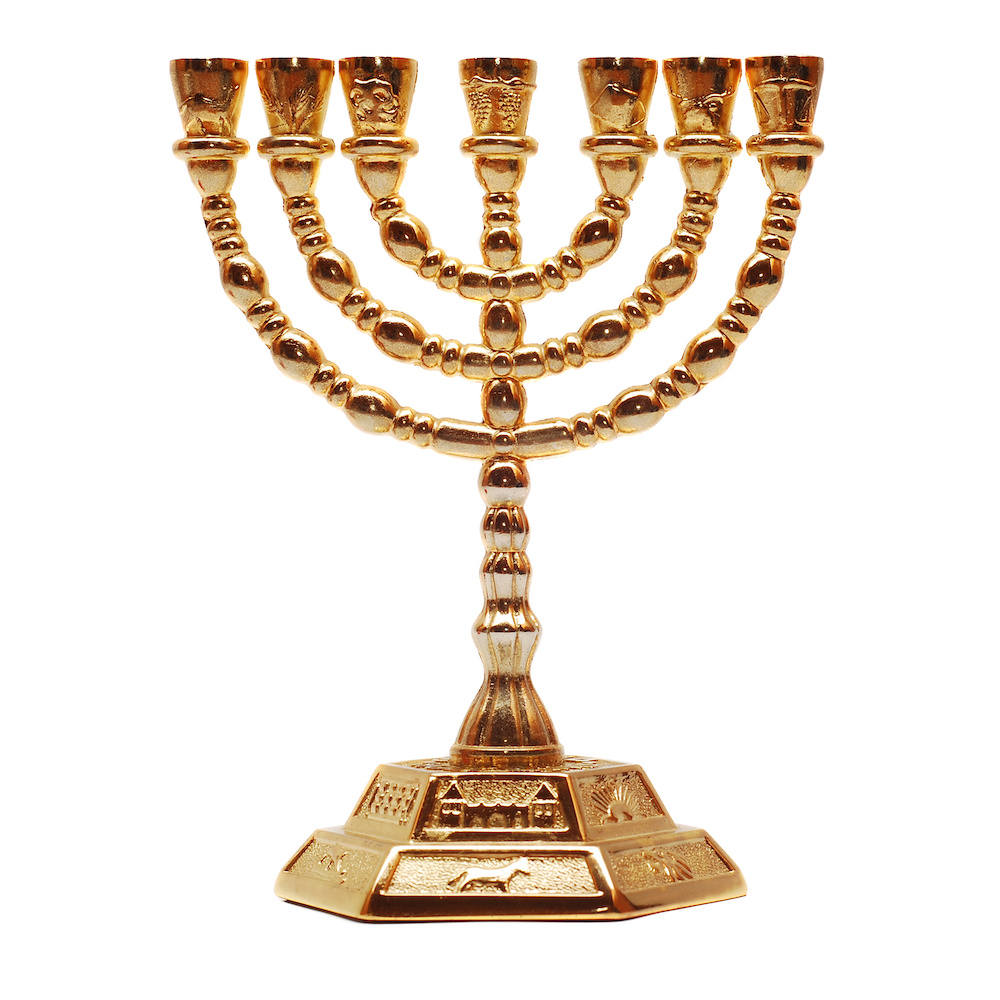
The seven-branched candelabra or menorah was beaten out of a solid ingot of pure gold and stood on the left side of the holy place inside the tabernacle. The menorah pictures both Yeshua and the saints as well as the divine light that comes from heaven to guide men through the spiritual darkness around them.
The menorah was the only light in that part of the sanctuary. It had seven branches with three on either side of a central stem. Each branch had three decorative cups, a knob and a flower resembling that of an almond tree. The cups were called lamps and each was filled with the purest olive oil and contained a linen wick. The menorah was lit each day, and each of the six outer lamps were designed, so that when lit the flame of each pointed toward the central stem. The menorah had tools including tongs and spoons with which to tend the wick. These implements were used to clean and prepare the lamps and to remove the previous day’s ashes.
The menorah prophetically pictures Yeshua the Messiah, the Tree of Life, who likened himself to a vine and his followers to its branches (John 15:1–7), as well as to the idea that the saints are members of the body of Yeshua (1 Cor 12:12), and are established in him (2 Cor 1:21). As spiritual branches, Yeshua’s followers are connected to him, draw their spiritual life or sustenance from him.
The menorah also prophetically points to Yeshua who is the Light of the world (John 1:7,8:12; 9:5; 12:46 cp. Rev 1:16), and that of his saints. The lives of his disciples are to reflect that light as it guides and directs them in all that they do, say and think, so that they in turn can be like lights on a hill shining in the darkness of the this world (Matt 5:14–15).
Moreover, the Scripture enjoins the saints to be spiritually “on fire” for Yeshua, zealous in obeying him and to be doing the work to which he has called them (Tit 2:14; Rev 3:14–21; Eph 2:10).
The olive oil that fuels the menorah symbolizes both the Spirit of Elohim and the Word of Elohim. It is by the former that the latter is revealed and understood. For example, on the Day of Pentecost, we see how the saints in the upper room received the fire of YHVH’s Spirit and had his Torah-law written in their hearts in fulfillment of Jeremiah’s prophecy (Jer 31:31, 33). Through the empowerment of the Spirit — both the fruits and the gifts — the Book of Acts saints were then able to take the light of the gospel out to the world.
The significance of the menorah in the believer’s life is evidenced by the fact that Scripture reveals that it (not the cross as is typically taught in Christianity) is the actual symbol for assembly of believers in Yeshua (Rev 1:12, 20).
The Table of Showbread (Exod 25:23–30)

On the right side of the tabernacle’s sanctuary opposite the menorah was the table of showbread. It was constructed of acacia wood overlaid in gold, which, again, foretells of the two-fold nature— both human and divine—that Yeshua the Messiah would possess when he made his appearance on earth some 1,500 years later.
The table had a crown of gold, which pictures Yeshua’s kingship and his being the spiritual head of the saints, which are symbolized by the twelve loaves of unleavened bread resting on the table. These twelve loaves of bread represent the twelve tribes of Israel in communion with each other as well as with YHVH. This bread was replaced with fresh loaves every Sabbath (Lev 25:5–9). These loaves represent the whole house of Israel including New Testament saints fellowshipping around Yeshua, the Bread of Life.
The twelve loaves were unleavened. Since leavening is a biblical metaphor for sin, this unleavened bread indicates that the saints are to be without sin when coming into the presence of Elohim.
Why do we say New Testament saints? Simply because Paul makes it clear that when anyone (even biologically non-Israelites) comes to Yeshua, he or she is automatically grafted into the spiritual entity known as the nation of Israel along with its covenants with the Elohim of Israel. One is no longer a Gentile or pagan’ (Rom 11:11–32; Eph 2:11–19).
Scripture also refers to the table of showbread as the bread of presence, since the word showbread in the Hebrew literally means “the bread that is in front of, before or in the face of” Elohim.
The Golden Incense Altar (Exod 30:1–10)
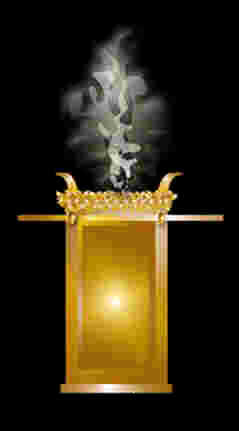
The golden incense altar was also constructed of acacia wood covered in gold and was situated in front of the veil leading into the holy of holies (or the most set-apart place) halfway between the menorah and the table of showbread.
Like the table of showbread, it had a golden crown around the top of it, which points to Yeshua being the head of his church.
The priest burned incense on the altar twice daily, in the morning and the evening. This speak prophetically of the saintly lifestyle of continual, twice daily prayer and worship.
Scripture reveals that incense represents the prayers of the saints rising up to heaven before the throne of Elohim (Ps 141:2; Rev 5:8), which in the tabernacle is pictured by the mercy seat located in the holy of holies (or the most set-apart place) and also knows as the oracle (Heb. d’veer).
The altar of incense was a place of deep prayer, praise, worship and intercession and speaks directly to the intimate, twice daily prayer life and devotions of the born-again believer before the throne of the Father in heaven.
The Veil (Exod 26:31–37)
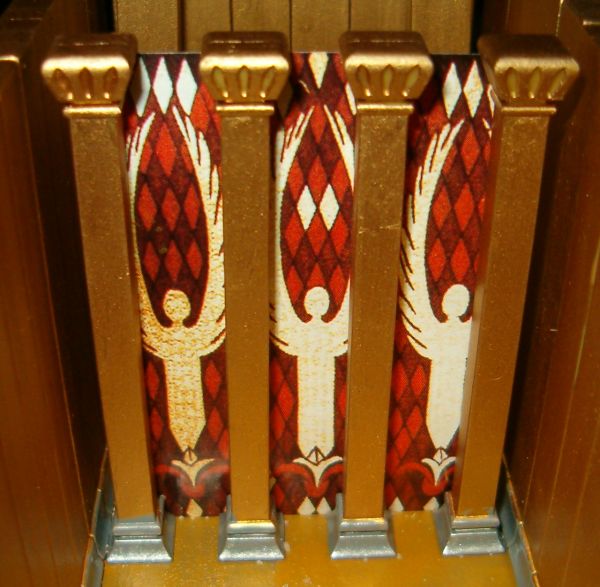
The veil or parochet was a curtain that divided the holy or set-apart place from the holy of holies or most set-apart place. It was woven of fine linen of the same four colors as the previous two curtains — blue, crimson, purple and white, except this veil had cherubim embroidered into it. This was a picture of entering into the very presence or throne room of Elohim in heaven.
The most set-apart place also prophetically pictures returning to the Garden of Eden, which had cherubim guarding its entrance (Gen 3:24), except this time this pictures entering the spiritual garden of YHVH’s eternal kingdom which the Book of Revelation refers to as the New Jerusalem in the New Heaven and New Earth (see Rev 21 and 22).
It was this same veil that was rent from top to bottom in the second temple in Jerusalem at the time of Yeshua’s crucifixion (Matt 27:51). The writer of the Epistle to the Hebrews makes a correlation between the tearing of Yeshua’s flesh on the cross and the tearing of the veil, and indicates that our Savior’s death opened the way for the saints to be able to enter into the most set-apart place and to come boldly before the throne of Elohim through the shed blood of Yeshua (Heb 10:19–22 cp. 4:14–16).
The Most Set-Apart Place
The holy of holies or most set-apart place was the small inner-most room of the tabernacle, which contained the ark of the covenant over which the pillar of fire or glory cloud rested and represents the throne room of Elohim in heaven.
Only the high priest was allowed to enter the most set-apart place, and only then once a year on the Day of Atonement. This room, where the glory of Elohim resided, symbolically represents the very throne room or presence of YHVH Elohim, our Father in heaven, itself, which the saints are now able to enter through prayer, praise and worship as a result of one’s personal relationship with Yeshua the Messiah (Heb 4:14–16).
The Ark of the Covenant (Exod 25:10–22)
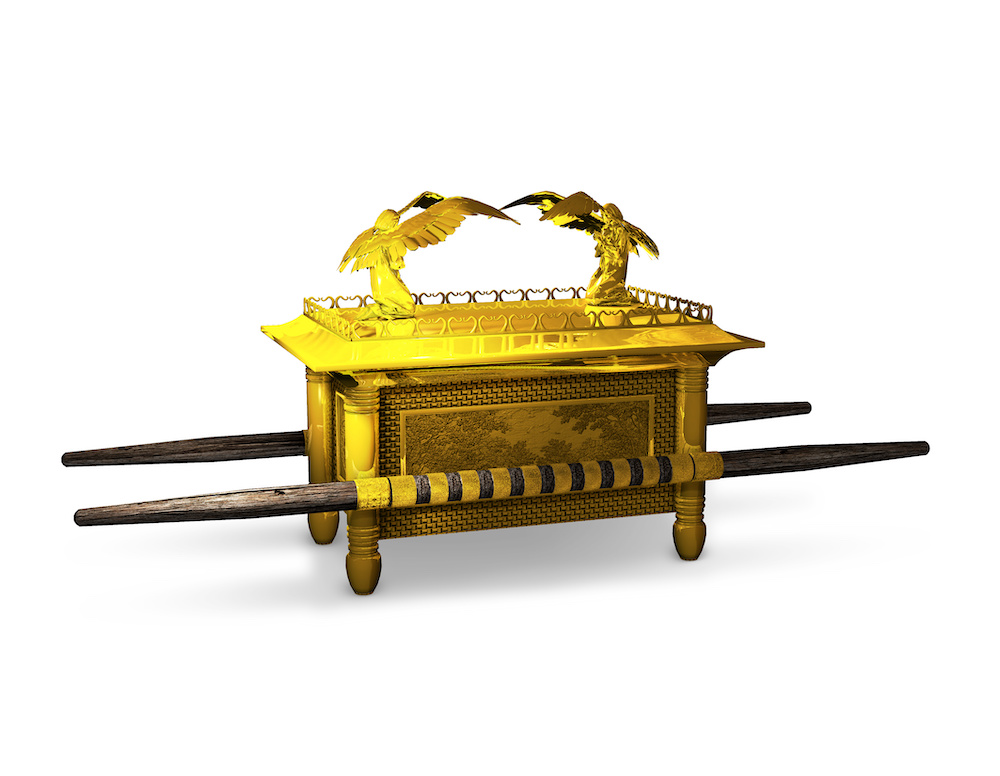
The ark of the covenant was a small box of acacia wood overlaid in gold, which contained the golden pot of manna, Aaron’s rod that budded and the two tablets of stone containing the ten statements of Elohim — commonly called the Ten Commandments. Against the ark was leaned a scroll of the complete YHVH’s Torah-law (Deut 31:26).
While the most set-apart place symbolically represents the throne room of Elohim in heaven, the ark of the covenant represents his actual throne where he extends mercy to repentant humans. It is this throne that the saints come before each time they pray, praise and worship (Heb 4:16; Rev 5:8–10; 8:2–4). All of this is possible through a relationship with Yeshua, our Great High Priest, who is interceding for his people before this Father’s throne in heaven (Romm 8:34; Heb 7:25; 1 John 2:1).
Covering the ark was a golden lid or cap called the mercy seat. In Hebrew, this is called the kapporet and is related to the word kippur as in Yom Kippur, the Day of Atonement. Both words share a common Hebrew root, which is the word kapar, which according to The Theological Wordbook of the Old Testament means “to make an atonement, make reconciliation, purge.”
The mercy seat — the golden lid covering the ark of the covenant located in the d’veer (i.e., the inner shrine of the Tabernacle of Moses) — which in Hebrew is the word kapporet, was “the place of atonement or the place where atonement was made.” The TWOT defines what happened at the kapporet as follows:
“It was from the…mercy seat that [YHVH] promised to meet with the men [of Israel] (Num 7:89). The word, however, is not related to mercy and of course was not a seat. The word is derived from the root ‘to atone.’ The Greek equivalent in the LXX is usually hilasterion, “place or object of propitiation,” a word which is applied to [Messiah] in Rom 3:25. The translation ‘mercy seat’ does not sufficiently express the fact that the lid of the ark was the place where the blood was sprinkled on the day of atonement. ‘Place of atonement’ would perhaps be more expressive.”
The mercy seat covering the ark that contained the Torah is a vivid symbolic picture of YHVH’s mercy for repentant humans triumphing over his judgment against their sin (Jas 2:13). We all deserve death for violating his commandments, for the wages of sin is death (Rom 6:23) and sin is the violation of YHVH’s Torah commands (1 John 3:4). Yet when we repent of our sins and place our faith in Yeshua’s atoning death on the cross as payment for those sins, YHVH forgives us and grants us his merciful grace (1 John 1:9–2:2).
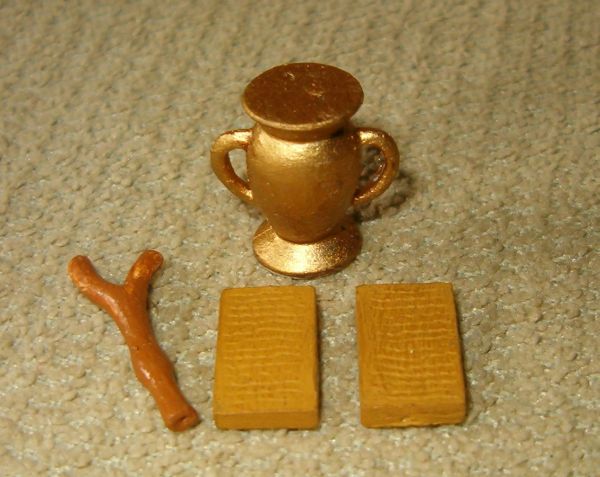
Everything in, on and around the ark of the covenant pointed to Yeshua. Inside the ark was the golden pot of manna, which points to Yeshua who is the bread of life (John 6:41–58) — the Word of Elohim made flesh (John 1:1, 14). Aaron’s rod that budded prophetically symbolizes Yeshua’s role as the ultimate High Priest due to his atoning and life-giving work at the cross (Heb 8:1–6; 9:11–28; 10:11–18 ; 1 John 2:–2). The two stone tablets and the Torah scroll point us to Yeshua, who was the Word of Elohim from the foundation of the world (John 1:1, 14), and whose words or instructions in righteousness the saints are instructed to follow (John 14:15, 21; 1 John 2:3–6; Rev 12:17; 14:12).
Overshadowing the mercy seat were two golden cherubim with outstretched wings. This is a picture of YHVH’s throne in heaven, which is surrounded by cherubim and other living creatures that sing his praises and minister to him (Isa 6:1–3; Ezek chapter 1; Rev 4:6–11).
The Glory Cloud (Exod 40:34–38)
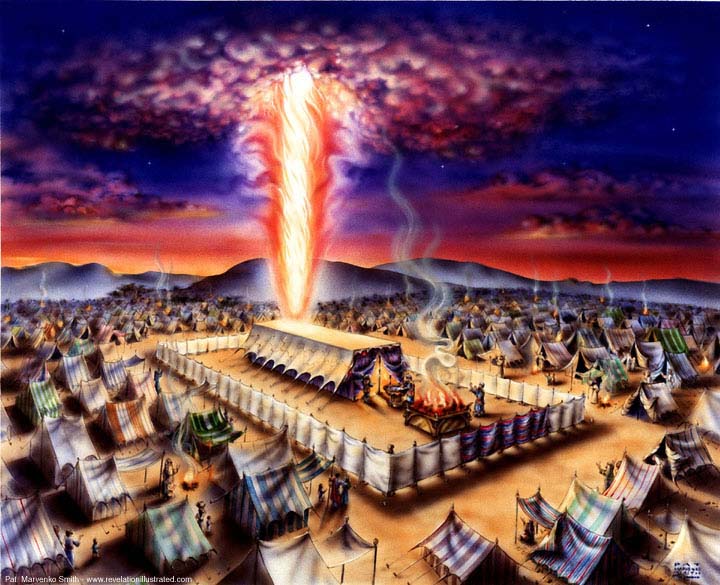
Directly above the mercy seat of the Tabernacle of Moses hovered the glory cloud—the manifest presence of YHVH Elohim (Lev 16:2 cp. Exod 40:34–38; Lev 9:23). This was the same cloud that led the children of Israel through the wilderness (Exod 40:36–37). This cloud was a minimal representation of the glory that surrounds Elohim and his actual throne in heaven (2 Chron 7:2; Isa 6:4; Ezek 1:26–28; 43:4-5; Rev 4:2–3;15:8; 21:24).
The glory cloud is not only a prophetic picture of the glory of YHVH Elohim that will be present in the New Jerusalem’s heaven on earth (Rev 15:8; 21:24), but of the glory that describes the resurrected, glorified saints of Elohim. To be glorified after a slight similitude of the glory that belong to YHVH Elohim is the ultimate destiny of the true saints of Yeshua.
But we all, with unveiled face, beholding as in a mirror the glory of the Lord, are being transformed into the same image from glory to glory, just as by the Spirit of the Lord. (2 Cor 3:18)
When Messiah who is our life appears, then you also will appear with Him in glory. (Col 3:4)
Therefore I endure all things for the sake of the elect, that they also may obtain the salvation which is in Messiah Yeshua with eternal glory. (2 Tim 2:10)
The elders who are among you I exhort, I who am a fellow elder and a witness of the sufferings of Messiah, and also a partaker of the glory that will be revealed. (1 Pet 5:1)
But may the Elohim of all grace, who called us to His eternal glory by Messiah Yeshua, after you have suffered a while, perfect, establish, strengthen, and settle you. (1 Pet 5:10)
Beloved, now we are children of Elohim; and it has not yet been revealed what we shall be, but we know that when He is revealed, we shall be like Him, for we shall see Him as He is. (1 John 3:2)
Conclusion
As we can see, the stations in the Tabernacle of Moses, from outside to inside, represents the steps that each human must take if they want to see Elohim and to be with him in his eternal kingdom forever.
The tabernacle is a blueprint that outlines a progressive process that each person must go through as they are transformed from a state of separation and estrangement from their Creator because of sin, uncleanness and unrighteousness to a state of holiness, purity and righteousness resulting in a personal relationship with the Almighty. The end result is immortality and existence in a glorified state abiding in the presence of YHVH Elohim forever.
Immortality is what every human seeks, and heaven has outlined the process as represented by the Tabernacle of Moses that each person must go through if they want immortality. There is no other way, despite what all the false religions of the world may say.
Moreover, everything in the tabernacle centered around and pointed to Yeshua the Messiah, who, as the Bible reveals, is the only way to the Father in heaven (Acts 4:12; John 14:6), for he is the only way, the Truth and the source of eternal life (John 14:6).


Wonderful teaching
This is just a wow! I enjoyed the teaching.